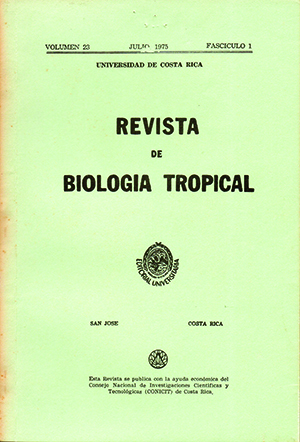Resumen
La anatomía foliar de las bromeliáceas mereció la atención de muchos investigadores como ANDRE (1), BEER (3), CHEVALIER (8), DUVAL (9), KOCK (13), MEZ (16), ROBINSON (22), SOLEREDER y MEYER (28) Y TOMLINSON (30). La mayoría de estos estudios describen las estructuras, sin establecer relación con la ecología de las plantas. Entre los trabajos anatómico·ecológicos realizados cabe destacar el de SCHIMPER (26), quien relacionó la economía del agua con el epifitismo, y la tesis de PICADO (19) sobre bromeliáceas de Costa Rica, en la cual se buscó la relación entre los depósitos de agua de las bases foliares y la nutrición mineral y entre la producción de mucílago en las hojas y la presencia de enzimas digestivas. TOMLINSON (30) brindó el mejor estudio moderno sobre anatomía de las bromeliáceas y estableció ciertas relaciones entre las estructuras y la ecología de las plantas. Pocos trabajos hay referentes a bromeliáceas xerófitas. TIETZE (29) estableció cuatro grupos de bromeliáceas basados en la estructura de la escama y el habitáculo en general. Su primer grupo corresponde a xerófitas terrestres que absorben agua por las raíces, con escamas no especializadas y asociadas con los estomas para reducir la transpiración. La segunda y tercera categorías incluyen otras formas más especializadas pero intermedias entre las xerófitas y las epífitas extremas más avanzadas como Tilfandsia, a las que Tietze colocó en la cuarta categoría. PITTENDRIGH (21) consideró más tipos que Tietze en las bromeliáceas de Trinidad. Dichas categorías no parecen corresponder a la evidencia anatómica en todos los casos (30) y es de desear una investigación más detallada.
Citas
ANDRÉ, E. 1889. Description et histoire des Broméliacées. G. Maisson, París. 40 pp.
ARENS, K. 1956. Consideracoes sobre as causas do xeromorfismo foliar. Bol. Fac. Filos. Univ. Sáo Pauto, Bot., 13: 25-53.
BEER, J. G. 1854. Versuch einer Bluethenstand. Eintheilung der Familie der Bromeliaceen na eh . deren Oesterr. Bot. Wochenbl., 4: 157-160.
BENZING, D. H. 1970. Ah investigation of two bromeliad myrmecophytes: TiIlandsia butzii y T. caputmedusae E. Morren and their ants. Bull. Torrey Bot. Club, 97: 109-115.
BROWN, H. T., & F. ESCOMBE 1900. Static diffusion of gases and liquids in relation to the assimilation of carbon and translocation of plants. Philos. Trans. Ser. B., 193: 223-228.
COLLINS, J. L. 1960. The pineapple. Interscience Publ., New York. 294 pp.
COUTINHO, J. M. 1959. Contribucao ao conhecimento da ecologia da mata pluvial tropical. Bol. Fac. Pilos. Univ. Sao Pauto, Bot., 16: 1-219.
CHEVALIER, CH. 1935. Les Broméliacées-Aechmeinées. Bull. Soc. Natl. Host. France, 6: 190-208.
DUVAL, L. 1806. Les Broméliacées. J. Lamarre, Paris. 150 pp.
FRANKE, W. 1967. Mechanisms of foliar penetration of solutions. Ann. Rev. PI. Physiol., 18: 281-300.
HEATH, O. V., & T. A. MANSFIELD 1969. The movements of stomata in the physiology of plant growth and development. p. 303-331. In : M. Wilkins (ed.), The physiology of plants. McGraw-Hill, Londres.
KAMP, E. 1930. Die Bromeliaceen. Jahrb. Wiu. Bol., 72: 403-428.
KOCK, E. 1858. Die Bromeliaceen mit dreitheilige Kapseln. Allg. Garlnerzlg. 26: 265-300.
LINSBAUER, K. 1911. Zür physiologischen Anatomie der Epidermis und des Durchluftungsapparates der Brome!iaceen. Sitzungsber. Kaiserl. Akad. Wiu., Math.-Naturwiss Cl., Abl. 1, 120: 319-348.
MARTIN, J. T., & B. E. JUNIPER 1970. The cuticle of plants. Arnold, London. 347 pp.
MEZ, C. 1896. Bromeliaceae, p. 702-742. In: C. De Candolle, (ed.), Monographiae Phanerogamarum, IX. Masson et Cie., Paris. 1028 pp.
O'BRIEN, T. P. 1970. Further observations on hydrolisis of the cell wall in the xylem. Protoplasma, 69: 1-14.
OSMOND, C. B., U. LUTTGE, K. R. WEST, C. K. PALLAGHY, B. SHACHER-HILL 1969. Ion absortion in Alriplex leaf tissue II. Secretion of ions to epidermal bladders. Austral. J. Biol. Sci., 22: 797-814.
PICADO, C. 1913. Sur les Broméliacées épiphyles considerées comme milieu biologique. These doctoral. Université de Paris, France.
PIENIAZAEK, S. A. 1944. Physical characters of the skin in relation to apple fruit transpiration. Pl. Physiol., Lancaster, 19: 529-536.
PITTENDRlGH, C. S. 1948. The bromeliad-Anopheles·malaria complex in Trinidad. I. The bromeliad flora. Evolución, 2: 58-59.
ROBINSON, H. 1969. A monograph on foliar anatomy of the genera Connellia, Cottendorfia and Navia (Bromeliaceae). Smilhsonian Contr. Bol., 2: 1-42.
RUINEN, J. 1956. The phyllosphere of leaves. Nature, 9: 177-220.
RZEDOWSKI, J. 1961. Vegetación del Estado de San Luis Potosí. Tesis doctoral. Instituto Politécnico Nacional, México.
SCHIEFERSTEIN, R. H., W. E. LOOMIS 1959. Development of the cuticular layers in angiosperm leaves. Amer. J. Bol., 46: 625-635.
SCHIMPER, E. 1894. Ueber Bau und Lebensweise der Epiphyten Westindiens. Bot. Zbl., 17: 192-195.
SLATYER, R. O. 1967. Plant-water relationships. Academic Press. New York. 237 pp.
SOLEREDER. H. & F. S. MEYER 1929. Bromeliaceae, I. Systematische Anatomi, der Monocotyledonen. IV. Berlín. 129 pp.
TIETZE, M. 1906. Physiologische Bromeliaceen-studien. II. Die Entwickelung der wasseraufnehmenden Bromeliaceen-Trichome. Naturwissenschaften. 78: 1-51.
TOMLINSON. P. B. 1969. Anatomy of Monocotyledons. III. Commelinales- Zingiberales. Clarendon Press, Oxford. 446 pp.
##plugins.facebook.comentarios##

Esta obra está bajo una licencia internacional Creative Commons Atribución 4.0.
Derechos de autor 1975 Revista de Biología Tropical


